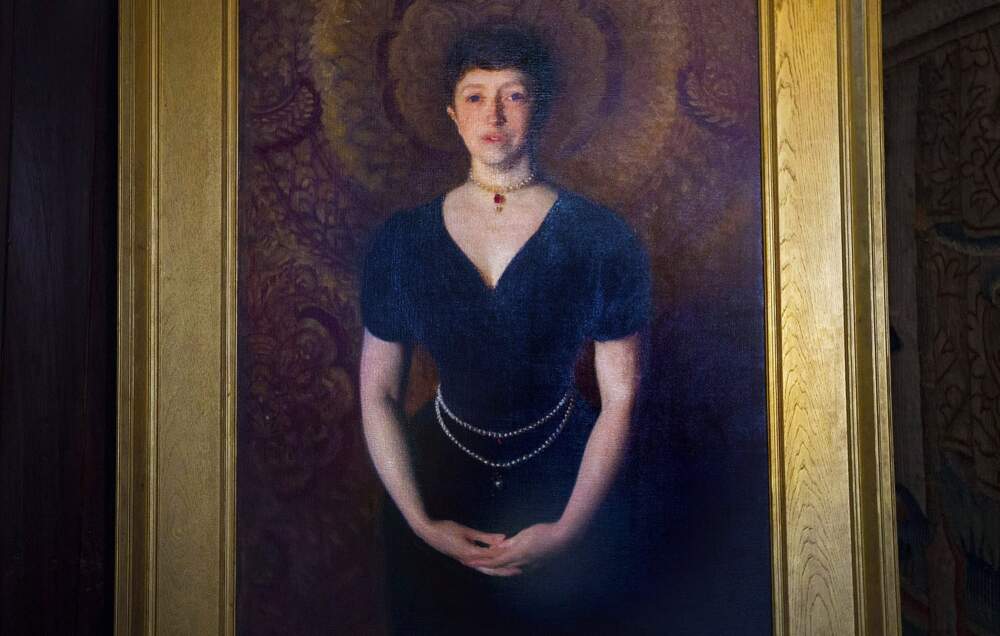Advertisement
Field Guide to Boston
What to know about Isabella Stewart Gardner, the woman behind one of Boston's most celebrated museums
Resume
Many know Isabella Stewart Gardner for her home-turned-museum, in which her personal items and vast private collection of notable artworks were ordered to be displayed after her death for visitors exactly as she left them.
This thou-shall-not-move-my-stuff mandate written into her will contributed to her reputation as idiosyncratic and iconoclastic, along with reports of her walking a lion in Copley Square and inappropriately sporting Red Sox gear at a Boston Symphony Orchestra concert. And both Gardner and the museum gained greater notoriety after her former home became the crime scene of the most the valuable — and vexing — art heist in history.
These defining moments, however, may have obscured who Gardner really was. Curators Diana Seave Greenwald and Nathaniel Silver offer a modern look at the collector, philanthropist and socialite in their 2022 book, "Isabella Stewart Gardner: A Life."
In an interview with WBUR's Radio Boston, the curators highlighted some of Gardner's characteristics that may not have been fully appreciated or understood — until now. We revisit that conversation as part of WBUR's Field Guide to Boston.
Here are their explanations about the woman behind one of Boston's most celebrated museums:
She was a careful curator of her image.
In other words, she managed to maintain an aura of mystery about her. Newspapers complained about having few images of the socialite, and few primary resources from her life remain. This appears to be intentional. Gardner instructed people to burn some correspondences with her. To this day, for example, there is also very little known as to why she wanted the museum to look the way it does.
Gardner was the first woman to build a museum in the U.S.
While not the only woman to do so, the number of woman founding museums during Gardner's lifetime was small. Her contemporaries included Peggy Guggenheim, who founded a museum inside her home in Venice, Italy, as well as Cooper Hewitt, the woman behind the New York City design museum that carries her name.
Still, Gardner "is the earliest woman to embark on this project of a purpose-built museum in the United States," said Seave Greenwald.
She changed the face of museum art collections in the country.
"The objects that she brought into it were pioneering. They were path-breaking in her own day," said Silver. Many museums today feature Italian Renaissance paintings. According to Silver, Gardner made that the norm.
"She brought the first Raphael painting to this country. She brought the first Botticelli to this country. ... She brought the first work by Giotto, by Simone Martini," he said. "The list goes on and on, but it changed forever the taste in art in the United States."
She also extensively collected Japanese and Chinese art at a time of widespread anti-immigration sentiments, the authors explained.
Gardner's approach also went against the "staid, encyclopedic model," which she disliked but was popular in many museums around the country like at the Museum of Fine Arts in Boston just across the way from the Gardner, said Seave Greenwald.
She was pro-immigration.
Though Gardner didn't speak up much on political issues, she spoke out against the anti-immigration federal policies of the early 1920s. In general, however, the authors noted she had the luxury to remain quiet on other issues when she felt like it.
She was really, really rich.
This is no surprise. While her wealth doesn't directly profit off of enslavement, Seave Greenwald and Silver discovered she had a paternal great-grandfather and a maternal grandfather who owned slaves; these ancestors' actions enabled the wealth and status Gardner inherited.
In her lifetime, which falls squarely in the Gilded Age, Gardner and her husband's wealth grew from investing in railroads and mining.
"As the owners of this capital, it really is the era of earning passive wealth and huge wealth inequality in this country, and they're kind of, for themselves ... acquiring that wealth that enables the type of activity like building a museum," said Seave Greenwald.
And yet ...
For all the fresh digging Seave Greenwald and Silver did into Gardner's life, they say she may beyond comprehension.
"The particular design of the Gardner, where there's really no labels ... is almost a hands-off approach where ... you get to take away from it what you will," Seave Greenwald said. "I think Gardner treats her legacy a little bit in the same way: I'm going to give you my name. I'm going to give you some pieces of evidence. But I will let you think of me what you will."
Diana Seave Greenwald is the interim William and Lia Poorvu Curator of the Collection at the Gardner. Nathaniel Silver is a former curator at the museum and now the director of the Hancock Shaker Village in Pittsfield, Massachusetts.
This segment aired on September 26, 2023.


